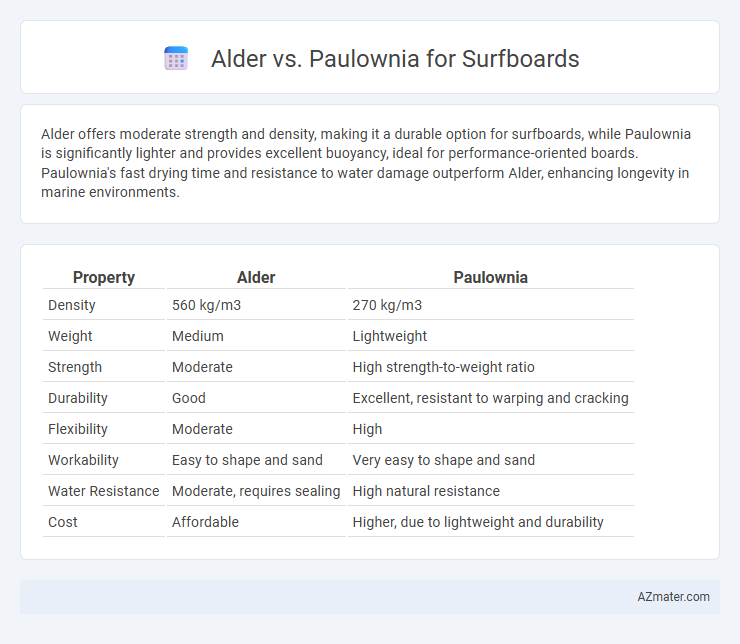Alder offers moderate strength and density, making it a durable option for surfboards, while Paulownia is significantly lighter and provides excellent buoyancy, ideal for performance-oriented boards. Paulownia's fast drying time and resistance to water damage outperform Alder, enhancing longevity in marine environments.
Table of Comparison
| Property | Alder | Paulownia |
|---|---|---|
| Density | 560 kg/m3 | 270 kg/m3 |
| Weight | Medium | Lightweight |
| Strength | Moderate | High strength-to-weight ratio |
| Durability | Good | Excellent, resistant to warping and cracking |
| Flexibility | Moderate | High |
| Workability | Easy to shape and sand | Very easy to shape and sand |
| Water Resistance | Moderate, requires sealing | High natural resistance |
| Cost | Affordable | Higher, due to lightweight and durability |
Introduction: Comparing Alder and Paulownia for Surfboards
Alder offers a dense, durable wood ideal for traditional surfboards, providing excellent strength and responsiveness in water. Paulownia is lighter and more buoyant, making surfboards easier to maneuver and ideal for performance-oriented riders. Both woods are popular, but Paulownia's low weight and resistance to water absorption give it a competitive advantage in modern surfboard design.
Wood Density: Alder vs Paulownia
Alder wood has a density of approximately 530 kg/m3, offering a balance of strength and moderate weight ideal for surfboard cores requiring durability. Paulownia is significantly lighter, with a density around 270-310 kg/m3, making it an excellent choice for ultra-light, responsive surfboards that prioritize buoyancy and agility. Choosing between Alder and Paulownia depends on desired performance characteristics: Alder provides sturdiness, while Paulownia ensures a lighter, more maneuverable board.
Weight Considerations in Surfboard Shaping
Alder wood is denser and heavier than paulownia, making surfboards crafted from alder more robust but less buoyant. Paulownia's lightweight properties enhance maneuverability and reduce fatigue for surfers, ideal for performance-oriented boards. Weight considerations heavily influence shape and material choice, with paulownia preferred for air travel and long sessions due to its superior lightness and strength ratio.
Strength and Durability of Alder and Paulownia
Alder offers superior strength and durability compared to Paulownia, making it a preferred choice for surfboards that require robust performance and resistance to impact. Paulownia is lightweight and flexible but less dense, which can compromise its durability under heavy use or rough ocean conditions. The dense grain structure of Alder contributes to better resistance against dents and wear, extending the surfboard's lifespan significantly.
Water Resistance and Buoyancy
Paulownia wood offers excellent water resistance due to its low density and natural oil content, making it highly resistant to water absorption and less prone to swelling or warping in marine environments. Alder wood, while moderately buoyant, absorbs more water over time, which can compromise its durability and increase weight during extended exposure to moisture. For surfboards, Paulownia provides superior buoyancy and longevity in wet conditions, making it a preferred choice for performance and durability in water sports applications.
Workability and Shaping Ease
Alder wood offers moderate workability with a fine, even grain that allows for smooth shaping and sanding, making it a popular choice for traditional surfboards. Paulownia, known for its lightweight and soft texture, excels in shaping ease, enabling quicker cuts and intricate designs with less effort. The choice between alder and paulownia hinges on balancing durability and lightweight properties, with paulownia providing superior workability for custom, high-performance surfboards.
Environmental Impact and Sustainability
Alder wood, known for its moderate density and durability, is sourced from faster-growing trees, making it a more sustainable option compared to slow-growing hardwoods. Paulownia is highly favored for surfboards due to its lightweight nature and rapid growth rate, which significantly reduces environmental impact by sequestering more carbon and requiring less land. Both woods offer eco-friendly alternatives to traditional foam cores, but Paulownia's lower carbon footprint and faster replenishment make it a superior choice for sustainable surfboard production.
Cost Comparison and Availability
Alder is generally more affordable and widely available in local markets, making it a cost-effective choice for surfboard construction. Paulownia, while pricier, offers superior lightweight properties and durability but is less commonly stocked, leading to higher procurement costs and limited availability. The price differential between Alder and Paulownia boards can significantly impact overall surfboard production budgets due to varying material costs and regional supply constraints.
Performance Differences in the Water
Paulownia wood offers superior buoyancy and flexibility compared to alder, making it ideal for high-performance surfboards that require responsive maneuverability and enhanced speed. Alder, being denser and heavier, provides more stability and durability but sacrifices some agility and quick responsiveness in the water. Surfboards crafted from Paulownia excel in dynamic wave conditions, while alder boards are better suited for surfers prioritizing strength and control over rapid performance shifts.
Choosing the Best Wood for Your Surfboard
Alder wood offers durability and moderate weight, making it a reliable choice for surfboards that require strength and flexibility. Paulownia wood is exceptionally lightweight and resistant to water damage, ideal for surfers prioritizing speed and ease of handling on the waves. Selecting the best wood depends on whether you value strength and resilience (Alder) or lightweight performance and moisture resistance (Paulownia).

Infographic: Alder vs Paulownia for Surfboard
 azmater.com
azmater.com